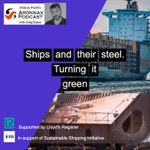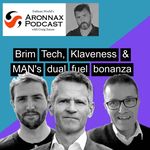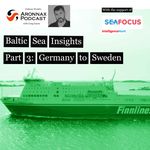Shipping's future ammonia engine
Hello and welcome to the Aronnax Show a podcast focused nt he transformation of the shipping, maritime and ocean space My name is Craig Eason, and I own and edit the Fathom World website.
Today’s show is focused on the efforts being made in the industry to develop the first engines capable of being powered by ammonia.
Ammonia is being seen by some as a key fuel for international shipping to decarbonise. It’s chemical composition (one nitrogen atom and three hydrogen atoms in each molecule) mean that it has no carbon that can be formed into carbon dioxide when it is burned in a marine engine. So CO2 emissions are zero.
Now I know there are arguments about how environmentally sound ammonia is. Today’s ammonia is largely made from LNG and other hydrocarbons so is grey ammonia, or at best blue. Green ammonia is that which is made using electricity from renewable sources.
However, regardless of the ammonia origin, it is the same molecule that is combusted to create power in an engine.
Another issue is that of laughing gas. When ammonia is burned it has the potential to produce laughing gas or N20- Laughing gas is a greenhouse gas and much worse than CO2
MAN ES in Copenhagen has promised to have an ammonia two stroke engine on the market by 2024. It also announced a recent project to develop a four-stroke engine.
My guest on this episode is Brian Østergaard Sørensen who is head of two stroke research in Copenhagen, and responsible for the trials in the company’s test facilities in the Daish capital.
I spoke with him just over a year ago when the company announced an enlargement of its test facilities to accommodate increased interest in new fuels.
So, I caught up with him to ask about what has been happening in the last year since we spoke and what needs to happen for the industry to get an ammonia engine from MAN.
Brian Østergaard Sørensen
Yeah, so, so thanks a lot, Craig for for inviting me back and I'm actually happy to be here today and share some of the insights that has happened over the last over the last 12 months. A lot of activity has gone through has been going on in relation to the development of our ammonia engine, we have come quite far we have established you can say a number of of initiatives together with other partners, we are working closely together with with fuel supply makers with classification societies with universities in the development. So, while we have not had you can say one of our two test engines in the research and the Copenhagen running on ammonia yet, we have done a lot of the initial preparations for this. So, it is preparations in terms of understanding the, you can say, the fuel supply system characteristics. It is dealing with with the safety and the health hazard that ammonia as a fuel is posing and some of the challenges we see in the engine design around that. We have looked at the engine itself. What does it require in terms of materials? What do we need to change? Do we see any immediate challenges here and of course, we have been looking at, you can say more from a theoretical angle, on the combustion characteristics and and started to look into some of the automation algorithms, the performance metrics we will be using. And then we have recently started to look into the emission side as well. And we are in a consortia around that to look at in case you have certain types of emissions you need to deal with -what what would that entail in terms of technical developments?
Craig Eason
When you're looking at the fuel supply side of things, so start at the beginning there in terms of the process of how things would go through the engine - when you're looking at the fuel supply side ammonia would be supplied onto the ship as a liquid. What can you tell me about so far that you know so far about how you would then have that fed into a dual-fuel engine? What sort of temperature what sort of pressures and what sort of considerations would you need to have for that part of the process?
Brian Østergaard Sørensen
Yeah, so we believe the storage shoe you can say on board is easier than other types of fuel. So we believe it is well known to to the industry. What we're looking at presently is supply pressure around 80 bar or so in the system. And then we do not see any major challenges handling, you can see it being supplied to to the engine. We have seen other tool fuel type installations where we have dealt with these challenges. So, from that perspective, we do not see major challenges for ammonia. One thing I have to say though is that ammonia Of course, can be a corrosive and we need to handle that and that is why the material part in it needs to be to be dealt with quite carefully. So, so, we have we have generated a fuel specification which which we believe will will be the right one for for our engines and and that is now available and here the one of the important parts is that there needs to be a little water in the ammonia for it it to be compatable with with the materials we currently have.
Craig Eason
So, would the ammonia that you're talking about here, would it be the same kind of ammonia that we're seeing supplied to other industries? Is it the same ammonia or would it be a bit like marine fuels today would it be marine grade ammonia?
Brian Østergaard Sørensen
It will look very much very much the same. There could be something around around purity water content and so on. And that is why we have made this specification to actually be able to to give quite a good guidance on this, but it will not be significantly different from from what you see today.
Craig Eason
So,I'm not asking you on the pricing side of things, but there won't be that significant pricing difference between ammonia that is in society and ammonia that is going to be used for marine use.
Brian Østergaard Sørensen
No we don't we don't believe show that you can say the ammonia available today though is generated from a fossil base and and what we are talking about of course is is green ammonia. But from an engine builder/designer point of view, the molecule is the same. So, whether it is fossil based or whether it is coming from renewable energy for our engine, it does not matter but of course it matters for the overall sustainability of the system you can say.
Craig Eason
you mentioned you've looked at the the kind of the theoretical side of the combustion in the engine which you get to construct in the in your test center in Copenhagen What can you tell me about the combustion cycle then of ammonia in these kind of engines?
Brian Østergaard Sørensen
Yeah, so, so, what we have we have looked at you can say the LTI concept we are having that is the liquid-to-gas injection platform we have in our engine program. And then we have looked at the characteristics around around ammonia - you can say flame speed, different combustion characteristics, and what do we believe the pilot fuel amount would be what would the flame propagation speed be and so on. And I think that that has been important for us to establish the the starting set of parameters once we start the single sylinder tests. Then of course, during those tests, we will we will challenge the boundaries and we will we will continuously optimize the combustion.
Craig Eason
One of the things with LNG of course is methane slip and you've been addressing that with a number of different technologies including exhaust gas recirculation and SCR selective catalytic reduction there are a number of ways that you've been working on NOx and methane slip and other things like that, what would happen with incomplete ammonia combustion? What what do you see is that after emissions part of the ammonia combustion?
Brian Østergaard Sørensen
So, we still believe we need some sort of after treatment system. So when SCR would would be would probably be a good choice we need to deal with the NOx and some of the active ingredients in in some SCR, the selective category reactors are actually ammonia and we have that in abundance on board.
So the NOx needs to be dealt with. And we also believe in this way we can actually deal with the ammonia slip. The challenge will be if we get the generation of laughter gas (N2O) which is a very potent greenhouse gas. So so we do not want to end up with a solution where we have exchanged you can say CO2 as a greenhouse gas with another very potent greenhouse gas. So it's important for us that the footprint - the environmental footprin- is low. And that is why we need to deal with the with the N2O if that is formed. So our first option would be to deal with it through the combustion process and and basically not generate the laughter gas, if that turns out not to be feasible, then we would need some sort of after treatment technology to deal with the with an after gas that it has been done before you can say on shore side. So, it is not completely unknown technology. But then of course needs to be adapted to a marine environment and to the conditions we have we will have as part of the engine system.
Craig Eason
A lot of the engines that you've been developing over the last 510 years have all been notably dual fuel when it comes to alternative fuels, whether it's ethane, LNG, methanol, they're all they all tend to be dual fuel. Why are you looking almost exclusively at dual fuel? Why not go for single fuel solutions then potentially could have higher efficiency.
Brian Østergaard Sørensen
I think this is also you can say it is all a backup solution for for many ship owners, you can say. Let's say that here in the transition phase and for the next many years, you would not have ammonia available then you would be able to go back to diesel oil for example. So, it gives you more flexibility on the solution on the dual fuel solution. That is one of the reasons we have developed this you can say the dual fuel approach.
Craig Eason
And the the option for dual fuel you mentioned diesel with ammonia here are we looking at simply two fuels are we looking at a multiple option here would in a single engine be able to take two fuels, whichever ones the ship owner decides it wants to have as its options or multi fuel engine. So, you got three fuiels that you could choose from
Brian Østergaard Sørensen
I think I think many people would like to have that option, I do not see this as as the first generation. This will be you can say this will be either a diesel oil mode or an ammonia mode. And the reason being that some of the the the auxiliary systems would would be different, some of the pressures could be different, maybe the lubrication oil we are using on the engine would have to be different. And that is why it is not just the switch of a button that you can change from LNG for example to ammonia. What we are looking into is to modularize our engine design. So so we make a transition from one to the other as easy as possible in terms of rebuilding or retrofitting an engine, that is something we have an eye for.
Craig Eason
So that gives an owner that confidence perhaps that there is a solution, if they go down a particular avenue, there is a solution that is more affordable than actually trying to take out a whole engine, which of course is nigh on impossible on a large ship anyway.
Brian Østergaard Sørensen
Yeah. And so, so, this future proofing The engine is one of our you can say one of the mantras we have and then in the design work making sure that that if you choose a conventional engine or or a different second fuel engine today, then it can be rebuilt later on. So, while we will have the first you can say ammonia engine design available in 2024, we will also be focusing on having a retrofit solution available approximately a year later in 2025 allowing for rebuild. And then there are certain preparations you can make and I know a lot of people in the industry is looking into to this, saying you know what, what will have to be done both in terms of of the engine that is our area, but also in terms of tank capacity, in terms of venting areas and so on. So, it goes beyond just the engine or the supply system for the engine. It actually you need to think in the this ship design basically, when you look ahead.
Craig Eason
You mentioned the test engine, your test facility in Copenhagen and you haven't built this ammonia engine yet or we haven't converted the engine that you've got in and that's an important distinction - you're not building an engine from scratch here in Copenhagen. You've got two engines and you effectively retrofit them to test capabilities on new fuels. And you've been doing that with the first engine. And it's only recently that you got the second engine in the same process then as well? When do you see yourself starting to do the tests on ammonia in Copenhagen
Brian Østergaard Sørensen
We plan to start on that during next year, and then we will do it throughout 23. So, we will be starting to run on one cylinder and then you can say test the characteristics on one cylinder and then you move from there to the four cylinders. So, the complete engine and that is how we are normally doing you can say the development. So, a single cylinder will give us a lot of indications around combustion characteristics and so on. And of course, when you then go to the full engine, then then you can really play with the with the control system and then look at the emissions and optimize the performance. So, that is the normal development cycle which we have also used on some of our other other developments like the ME-EA we recently released an ME-GI before that and so on.
Craig Eason
How do you then take that engine design then and give it to your partners that build the engines I'm not sure if many people really know this. But as a, you know, as a world renowned marine engine maker, you don't actually make most of the engines- the two stroke engines you have licensees that then make them for you around the world, notably in China, Korea, Japan, where the major shipbuilding takes place. How do you then take this new design for an ammonia engine and show it to them about how to build an ammonia engine to go into a brand new ship.
Brian Østergaard Sørensen
So, so, basically, we are taking the learnings from our test engine from test centre, and then we build it into a design during that phase, when we are designing you can say, the commercial engine, then then we would for example, team up with a different technical people from from the various licensees, we will make sure that we have the right documentation and then you can say then basically we we built the first commercial engine together and that first commercial engine will actually go into a vessel. What we often do, then, depending on on on the magnitude of the innovations or the development, then there will be some R&D test time for the first prototype engine. That means that where you normally might test for a couple of weeks, then it could be we will be testing for for for a month or two months optimizing you can say that design. But due to the sheer size of these engines, it is simply not feasible to build one demonstration engine and then have that one standing there. So we will be demonstrating you can say the concepts on our test engine. And then the first commercial engine will serve as as a demonstrator if you can call it like that.
Craig Eason
A lot of the initial evolution of ammonia and hydrogen and these alternative fuel to seeing is happening around the coast, a lot of smaller vessels, coastal vessels, and so on. And that's and they quite often use four stroke engines. And I know that this isn't your area of research and expertise. But I just wanted to ask you about the other project that I saw were announced recently from MAN ES notably in Germany on four stroke engines, because I see there was a marine element to that as well what sort of project is that what sort of project you're involved in there relating to the evolution of a four stroke, ammonia internal combustion engine.
Brian Østergaard Sørensen
So, we work very closely together with our colleagues in the fourstroke you can say design area and and we share a lot of the data, there are commonalities and then there are things that are different. What we what we are discussing with them and what they are working on is when you look at a ship, you have the main propulsion system, which is often for the large seagoing vessels, two stroke engine, and then you will have power generation engines-gensets- that would often be fourstroke Indians, and I think many ship owners if you want a really zero carbon vessel, you need both actually to have the capability to run on on a zero carbon fuel. And what our colleagues in the fourstroke area is doing is that they are actually looking into, you know, how can we adapt ammonia as a fuel on their platform. And that is the work that they are going into now. They're they're looking into the initial area, what would it take for a four stroke engine to to be adapted to burn ammonia? And then they are looking very much into hydrogen as well. What would it take for for hydrogen to be burned on a four stroke engine? And that is because four-stroke engines are also used on the shore side for power generation, not only on on marine side.
Craig Eason
What what are the expectations here of using hydrogen, in an internal combustion engine in marine environment?
Brian Østergaard Sørensen
I think it's depending a little you can say, on who you ask. We think and we know it's for sure possible. We think the cost of storage on board and handling it on board would be quite high. And we see ammonia as an effective hydrogen carrier, basically, which is easier to handle on board and it's well known to the industry. And that is why we think that, that for large vessels, ammonia would probably be the preferred choice. But you could see coastal vessels and near-shore shipping going for for hydrogen, where you could bunker more frequently than you would do ona on a global trading vessel.
End
Support this show http://supporter.acast.com/aronnax.
Hosted on Acast. See acast.com/privacy for more information.








